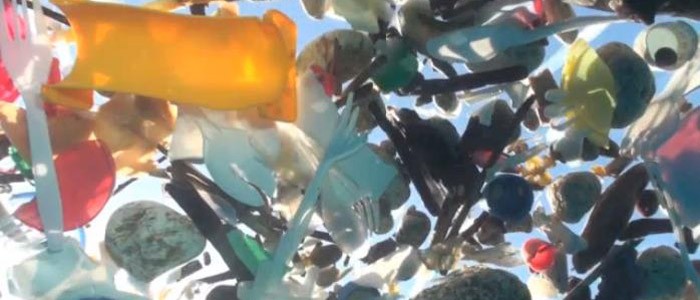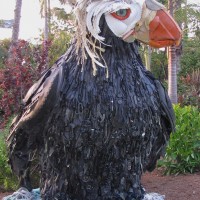Washed ashore: Art to Save the Sea
More than 315 billion pounds of plastic pollute our oceans, including the Great Pacific trash vortex, a vast patch of plastic debris that some estimates calculate as being twice the size of the continental United States.
This horrifying fact is embodied, quite literally, in dramatic sculptures of marine life made entirely from plastic trash collected from beaches. “Washed Ashore: Art to Save the Sea” on view for the first time in Washington, D.C. from May 27 through Sept. 5 at the National Zoo, underscores the need for wildlife conservation.
Seventeen sculptures, including a 12-foot-long shark, a 16-foot-long parrot fish, an 8-foot-wide octopus and a 20-foot-long coral reef, will be installed along the Zoo’s Olmsted Walk, in the Visitor’s Center and at the Amazonia exhibit. Visitors can see the living animals affected by marine waste, such as sea lions, brown pelicans and corals at the Zoo’s American Trail and Amazonia Science Gallery.
Based in Bandon, Ore., the Washed Ashore Project is a non-profit dedicated to educating and creating awareness about marine debris and plastic pollution through art.
“The National Zoo—America’s zoo—has given us a global platform to present our art to educate a world audience about how plastic pollution is posing a dangerous and perhaps catastrophic threat to the world’s oceans and sea life,” said Angela Haseltine Pozzi, lead artist and Washed Ashore executive director.
Under Pozzi’s leadership, Washed Ashore Project volunteers clean beaches and process the debris into art supplies. To date, thousands of volunteers have processed an estimated 18 tons of garbage collected from more than 300 miles of coastline to create 68 sculptures. As lead artist, Pozzi orchestrates the construction of these towering, striking sculptures of marine life. Each sculpture was created using hundreds of individual pieces, from flip-flops and bottle caps to nylon rope, Styrofoam and lighters.
Intricate and captivating, the sculptures in “Washed Ashore” are a powerful reminder of our personal role and responsibility in preserving global biodiversity on land and in the sea.
The Smithsonian’s National Zoo is committed to saving marine species and its Conservation Biology Institute is a pioneer in coral-reef research and conservation. The ocean produces more than 50 percent of the world’s oxygen, and coral reefs nurture more than a quarter of all marine life. Using procedures similar to those used in human sperm banks, SCBI scientist Mary Hagedorn and her team are global leaders in conserving coral reefs and the ecosystems that they build. Increased greenhouse gases are warming and acidifying oceans across the planet, causing a widespread coral-reef crisis. By pioneering coral cryo-conservation and collecting and storing coral sperm from threatened reefs to produce new colonies in the lab for captive-bred and wild-colony conservation, SCBI is building a potential lifeline for species under threat from climate change, pollution and overfishing. Scientists at the Smithsonian are helping ensure a future for coral reefs and the species that count on them for survival as ocean environments change.
(Click any image to expand.)
- From the exhibition, “Washed Ashore: Art to Save the Sea”
- From the exhibition, “Washed Ashore: Art to Save the Sea”
- From the exhibition, “Washed Ashore: Art to Save the Sea”
- From the exhibition, “Washed Ashore: Art to Save the Sea”
- From the exhibition, “Washed Ashore: Art to Save the Sea,” on view at the National Zoo May 27 through Sept. 5, 2016
Related Programs
Washed Ashore’s “Turtle Ocean” / On view beginning June 8
Sant Ocean Hall / National Museum of Natural History
In addition to the 17 sculptures on view at the National Zoo, visitors can see “Washed Ashore: Art to Save the Sea’s” “Turtle Ocean” in the National Museum of Natural History’s Sant Ocean Hall. Created by Washed Ashore director Angela Haseltine Pozzi, “Turtle Ocean” depicts an entangled Hawksbill turtle swimming in an environment of water-bottle sea jellies and beached flip-flop anemones along with marine-debris seaweed and coral made of old buoys, crates and buckets. Hawksbill sea turtles face many threats, including mistakenly ingesting marine trash for food. All six species of sea turtles found in U.S. waters are threatened or endangered. The Sant Ocean Hall is the Museum’s largest exhibit, providing visitors with a unique introduction to the majesty of the ocean. The hall’s combination of 674 marine specimens and models, high-definition video and the newest technology allows visitors to explore the ocean’s past, present and future. For World Oceans Day programming at the Sant Ocean Hall, visit the Museum’s website. For more ocean information, visit https://ocean.si.edu.
World Oceans Day Celebration
June 11; 10 a.m. – 2 p.m.; National Zoo
It is not just marine animals who depend upon the ocean for survival. Visitors can celebrate World Oceans Day at the Zoo with educational activities, animal demonstrations and crafts.
________________________________________________________________
Laurie Penland is the Smithsonian’s scientific diving officer. She took this video at the Smithsonian Research Station at Carrie Bow Cay, a small island off the southern end of Belize.
One day, to her and her colleagues’ surprise, she says, “everywhere you looked there was trash floating by” in the usually pristine water.
At the tail end of a research dive, with air left in her tank and battery life on her camera, Penland decided to investigate one particular garbage patch, about 100 meters long. “There was a lot of chop on the surface from the winds so as I approached the mass of trash from underneath, it was moving up and down like a swirling angry monster, reaching out to me then pulling back, then swallowing me whole.” Up close, you can make out plastic forks and spoons, bottle caps and rubber balloons.
The experience was a profound one for Penland, and she hopes the video will resonate with others. “I gave a lot of thought as to how I could live a plastic-free life. I have a box of plastic forks and spoons that I use for box lunches. I now wash them in the dishwasher with the rest of my silverware and will never buy them again. I also try to reuse any containers that I get from stores and restaurants,” she says. “This has eliminated any need to buy plasticware, so it saves money too!”
Posted: 23 May 2016









